2022 HYUNDAI TUCSON heater
[x] Cancel search: heaterPage 271 of 638
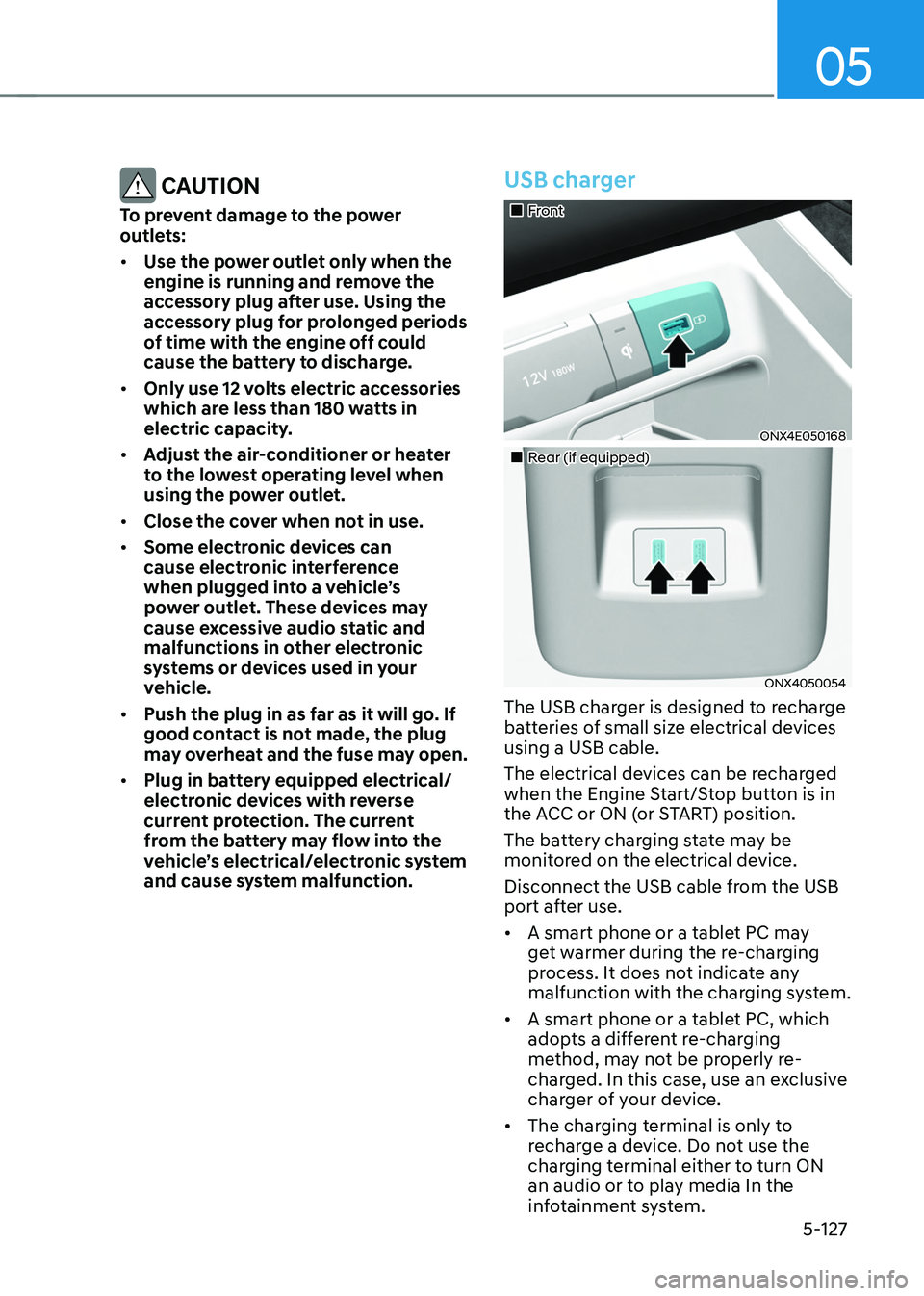
05
5-127
CAUTION
To prevent damage to the power
outlets:
• Use the power outlet only when the
engine is running and remove the
accessory plug after use. Using the
accessory plug for prolonged periods
of time with the engine off could
cause the battery to discharge.
• Only use 12 volts electric accessories
which are less than 180 watts in
electric capacity.
• Adjust the air-conditioner or heater
to the lowest operating level when
using the power outlet.
• Close the cover when not in use.
• Some electronic devices can
cause electronic interference
when plugged into a vehicle’s
power outlet. These devices may
cause excessive audio static and
malfunctions in other electronic
systems or devices used in your
vehicle.
• Push the plug in as far as it will go. If
good contact is not made, the plug
may overheat and the fuse may open.
• Plug in battery equipped electrical/
electronic devices with reverse
current protection. The current
from the battery may flow into the
vehicle’s electrical/electronic system
and cause system malfunction.
USB charger
„„Front
ONX4E050168
„„Rear (if equipped)
ONX4050054
The USB charger is designed to recharge
batteries of small size electrical devices
using a USB cable.
The electrical devices can be recharged
when the Engine Start/Stop button is in
the ACC or ON (or START) position.
The battery charging state may be
monitored on the electrical device.
Disconnect the USB cable from the USB
port after use.
• A smart phone or a tablet PC may
get warmer during the re-charging
process. It does not indicate any
malfunction with the charging system.
• A smart phone or a tablet PC, which
adopts a different re-charging
method, may not be properly re-
charged. In this case, use an exclusive
charger of your device.
• The charging terminal is only to
recharge a device. Do not use the
charging terminal either to turn ON
an audio or to play media In the
infotainment system.
Page 556 of 638
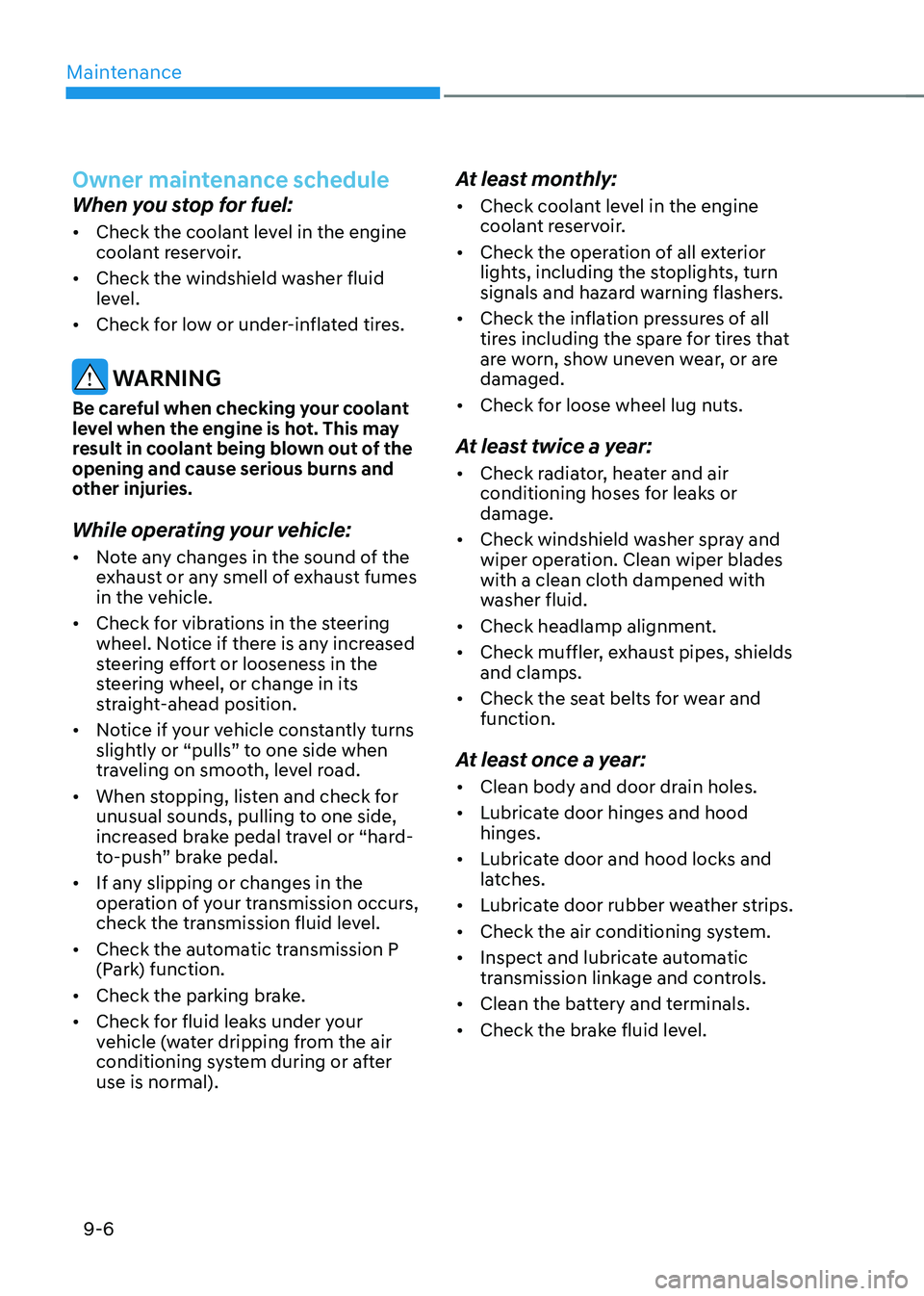
Maintenance
9-6
Owner maintenance schedule
When you stop for fuel:
• Check the coolant level in the engine
coolant reservoir.
• Check the windshield washer fluid
level.
• Check for low or under-inflated tires.
WARNING
Be careful when checking your coolant
level when the engine is hot. This may
result in coolant being blown out of the
opening and cause serious burns and
other injuries.
While operating your vehicle:
• Note any changes in the sound of the
exhaust or any smell of exhaust fumes
in the vehicle.
• Check for vibrations in the steering
wheel. Notice if there is any increased
steering effort or looseness in the
steering wheel, or change in its
straight-ahead position.
• Notice if your vehicle constantly turns
slightly or “pulls” to one side when
traveling on smooth, level road.
• When stopping, listen and check for
unusual sounds, pulling to one side,
increased brake pedal travel or “hard-
to-push” brake pedal.
• If any slipping or changes in the
operation of your transmission occurs,
check the transmission fluid level.
• Check the automatic transmission P
(Park) function.
• Check the parking brake.
• Check for fluid leaks under your
vehicle (water dripping from the air
conditioning system during or after
use is normal).
At least monthly:
• Check coolant level in the engine
coolant reservoir.
• Check the operation of all exterior
lights, including the stoplights, turn
signals and hazard warning flashers.
• Check the inflation pressures of all
tires including the spare for tires that
are worn, show uneven wear, or are
damaged.
• Check for loose wheel lug nuts.
At least twice a year:
• Check radiator, heater and air
conditioning hoses for leaks or
damage.
• Check windshield washer spray and
wiper operation. Clean wiper blades
with a clean cloth dampened with
washer fluid.
• Check headlamp alignment.
• Check muffler, exhaust pipes, shields
and clamps.
• Check the seat belts for wear and
function.
At least once a year:
• Clean body and door drain holes.
• Lubricate door hinges and hood
hinges.
• Lubricate door and hood locks and
latches.
• Lubricate door rubber weather strips.
• Check the air conditioning system.
• Inspect and lubricate automatic
transmission linkage and controls.
• Clean the battery and terminals.
• Check the brake fluid level.
Page 570 of 638
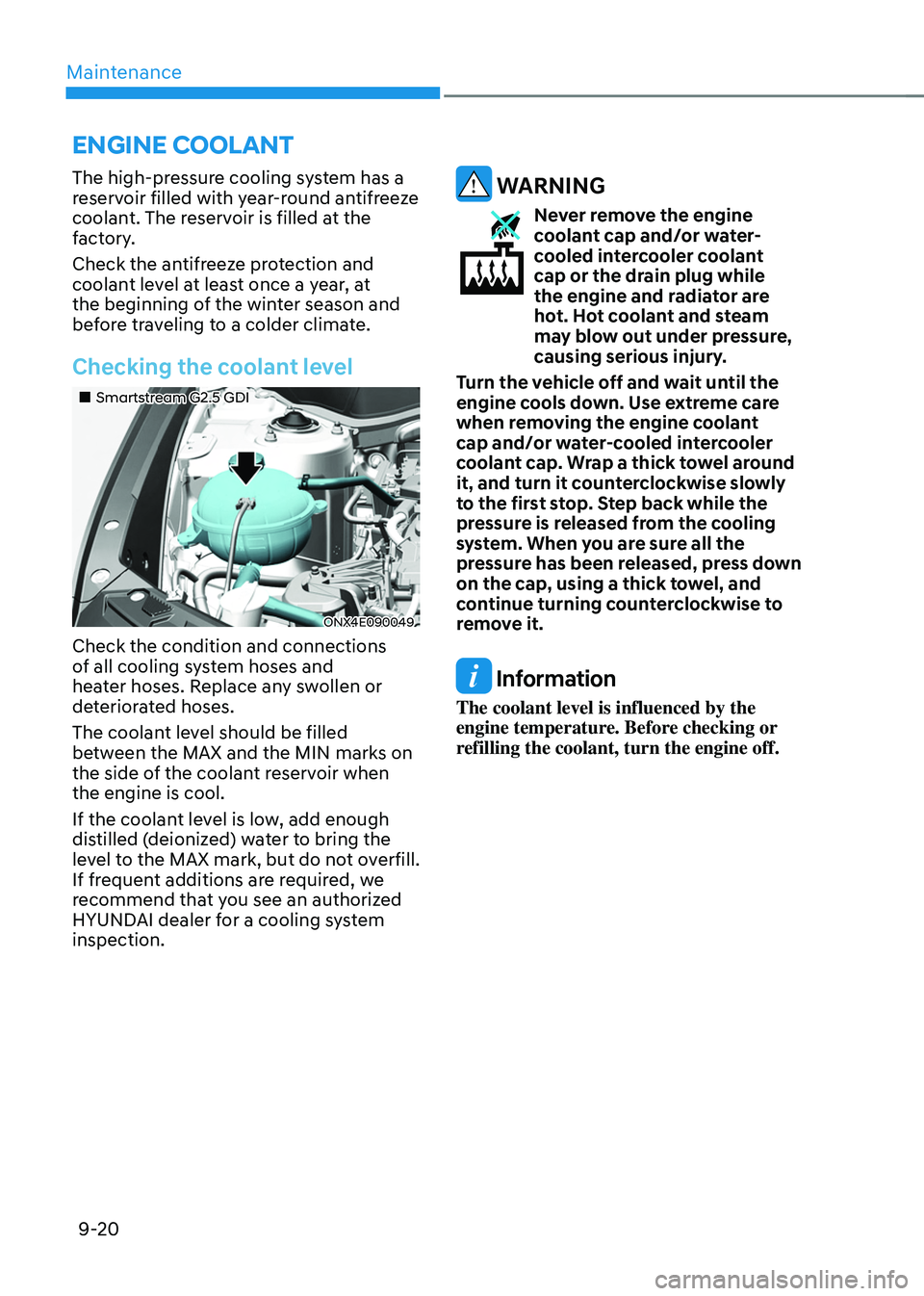
Maintenance
9-20
ENGINE COOLANT
The high-pressure cooling system has a
reservoir filled with year-round antifreeze
coolant. The reservoir is filled at the
factory.
Check the antifreeze protection and
coolant level at least once a year, at
the beginning of the winter season and
before traveling to a colder climate.
Checking the coolant level
„„Smartstream G2.5 GDI
ONX4E090049
Check the condition and connections
of all cooling system hoses and
heater hoses. Replace any swollen or
deteriorated hoses.
The coolant level should be filled
between the MAX and the MIN marks on
the side of the coolant reservoir when
the engine is cool.
If the coolant level is low, add enough
distilled (deionized) water to bring the
level to the MAX mark, but do not overfill.
If frequent additions are required, we
recommend that you see an authorized
HYUNDAI dealer for a cooling system
inspection.
WARNING
Never remove the engine coolant cap and/or water-
cooled intercooler coolant
cap or the drain plug while
the engine and radiator are
hot. Hot coolant and steam
may blow out under pressure,
causing serious injury.
Turn the vehicle off and wait until the
engine cools down. Use extreme care
when removing the engine coolant
cap and/or water-cooled intercooler
coolant cap. Wrap a thick towel around
it, and turn it counterclockwise slowly
to the first stop. Step back while the
pressure is released from the cooling
system. When you are sure all the
pressure has been released, press down
on the cap, using a thick towel, and
continue turning counterclockwise to
remove it.
Information
The coolant level is influenced by the
engine temperature. Before checking or
refilling the coolant, turn the engine off.
Page 599 of 638
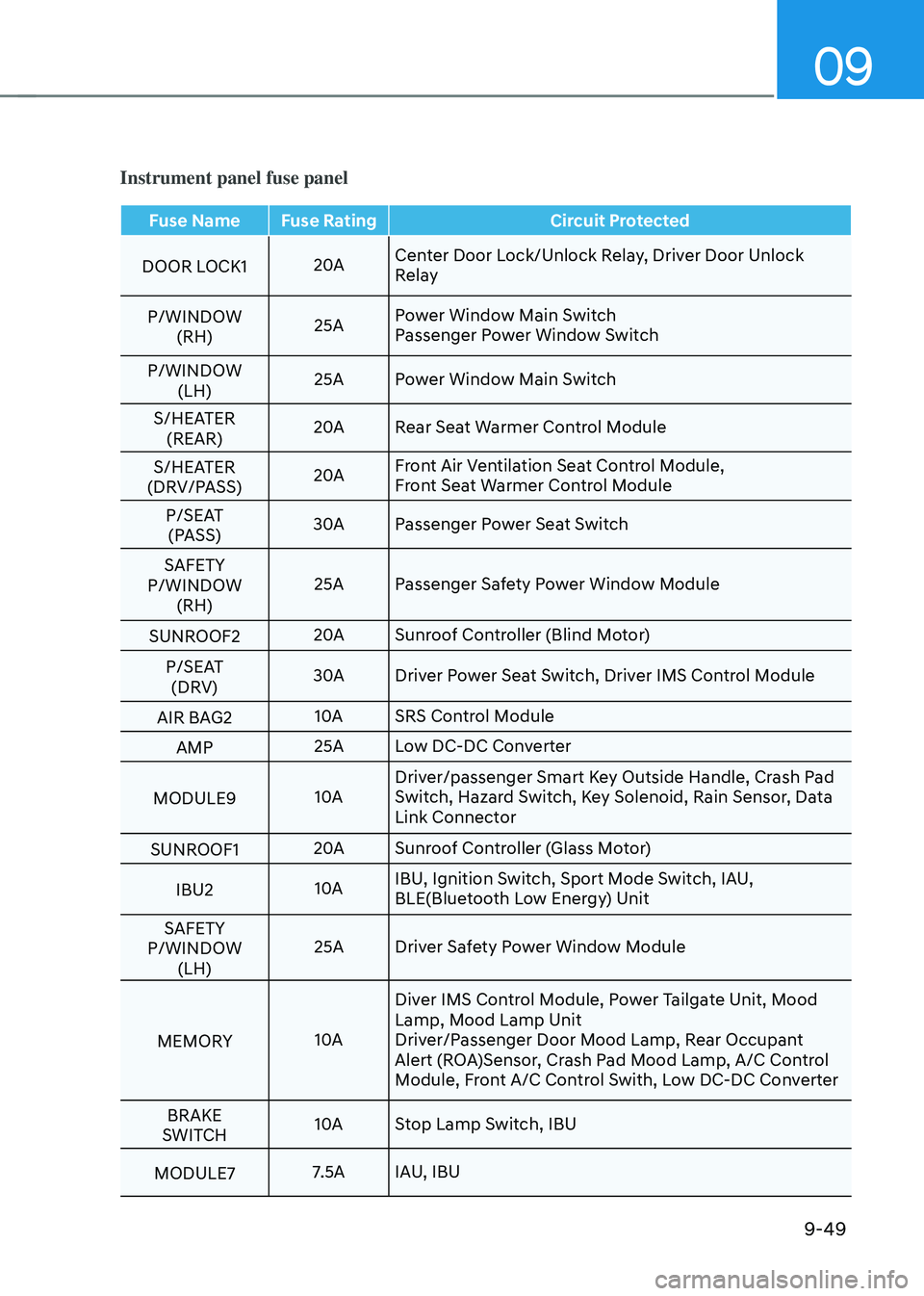
09
9-49
Instrument panel fuse panel
Fuse NameFuse Rating Circuit Protected
DOOR LOCK1 20ACenter Door Lock/Unlock Relay, Driver Door Unlock
Relay
P/WINDOW (RH) 25A
Power Window Main Switch
Passenger Power Window Switch
P/WINDOW (LH) 25A
Power Window Main Switch
S/HEATER (REAR) 20A
Rear Seat Warmer Control Module
S/HEATER
(DRV/PASS) 20A
Front Air Ventilation Seat Control Module,
Front Seat Warmer Control Module
P/SEAT (PASS) 30A
Passenger Power Seat Switch
SAFETY
P/WINDOW (RH) 25A
Passenger Safety Power Window Module
SUNROOF2 20A
Sunroof Controller (Blind Motor)
P/SEAT (DRV) 30A
Driver Power Seat Switch, Driver IMS Control Module
AIR BAG2 10A
SRS Control Module
AMP 25A
Low DC-DC Converter
MODULE9 10ADriver/passenger Smart Key Outside Handle, Crash Pad
Switch, Hazard Switch, Key Solenoid, Rain Sensor, Data
Link Connector
SUNROOF1 20A
Sunroof Controller (Glass Motor)
IBU2 10AIBU, Ignition Switch, Sport Mode Switch, IAU,
BLE(Bluetooth Low Energy) Unit
SAFETY
P/WINDOW (LH) 25A
Driver Safety Power Window Module
MEMORY 10ADiver IMS Control Module, Power Tailgate Unit, Mood
Lamp, Mood Lamp Unit
Driver/Passenger Door Mood Lamp, Rear Occupant
Alert (ROA)Sensor, Crash Pad Mood Lamp, A/C Control
Module, Front A/C Control Swith, Low DC-DC Converter
BRAKE
SWITCH 10A
Stop Lamp Switch, IBU
MODULE7 7.5A
IAU, IBU
Page 600 of 638
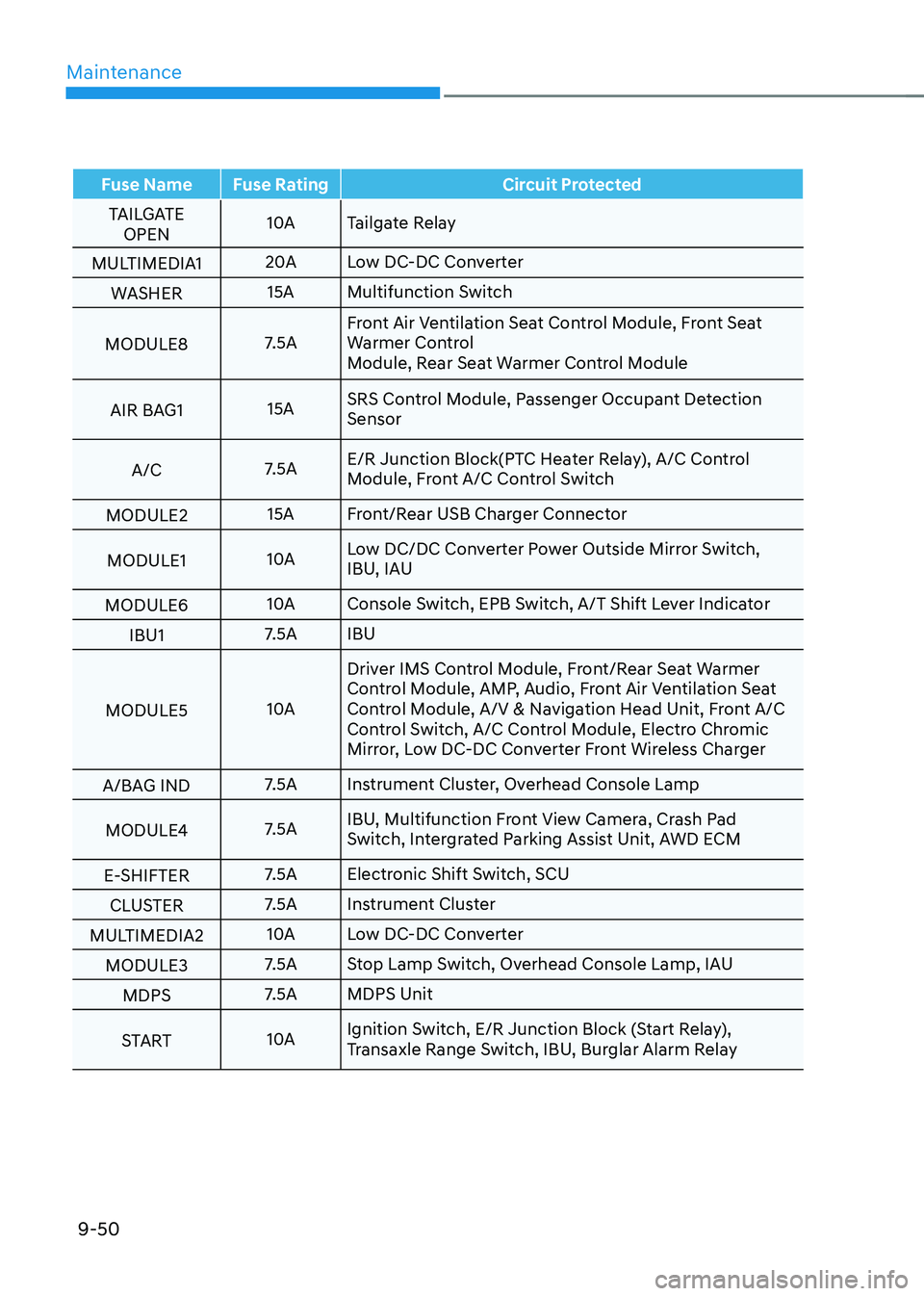
Maintenance
9-50
Fuse NameFuse Rating Circuit Protected
TAILGATE OPEN 10A
Tailgate Relay
MULTIMEDIA1 20A
Low DC-DC Converter
WASHER 15A
Multifunction Switch
MODULE8 7.5AFront Air Ventilation Seat Control Module, Front Seat
Warmer Control
Module, Rear Seat Warmer Control Module
AIR BAG1 15ASRS Control Module, Passenger Occupant Detection
Sensor
A/C 7.5AE/R Junction Block(PTC Heater Relay), A/C Control
Module, Front A/C Control Switch
MODULE2 15A
Front/Rear USB Charger Connector
MODULE1 10ALow DC/DC Converter Power Outside Mirror Switch,
IBU, IAU
MODULE6 10A
Console Switch, EPB Switch, A/T Shift Lever Indicator
IBU1 7.5A
IBU
MODULE5 10ADriver IMS Control Module, Front/Rear Seat Warmer
Control Module, AMP, Audio, Front Air Ventilation Seat
Control Module, A/V & Navigation Head Unit, Front A/C
Control Switch, A/C Control Module, Electro Chromic
Mirror, Low DC-DC Converter Front Wireless Charger
A/BAG IND 7.5A
Instrument Cluster, Overhead Console Lamp
MODULE4 7.5AIBU, Multifunction Front View Camera, Crash Pad
Switch, Intergrated Parking Assist Unit, AWD ECM
E-SHIFTER 7.5A
Electronic Shift Switch, SCU
CLUSTER 7.5A
Instrument Cluster
MULTIMEDIA2 10A
Low DC-DC Converter
MODULE3 7.5A
Stop Lamp Switch, Overhead Console Lamp, IAU
MDPS 7.5A
MDPS Unit
START 10AIgnition Switch, E/R Junction Block (Start Relay),
Transaxle Range Switch, IBU, Burglar Alarm Relay
Page 602 of 638
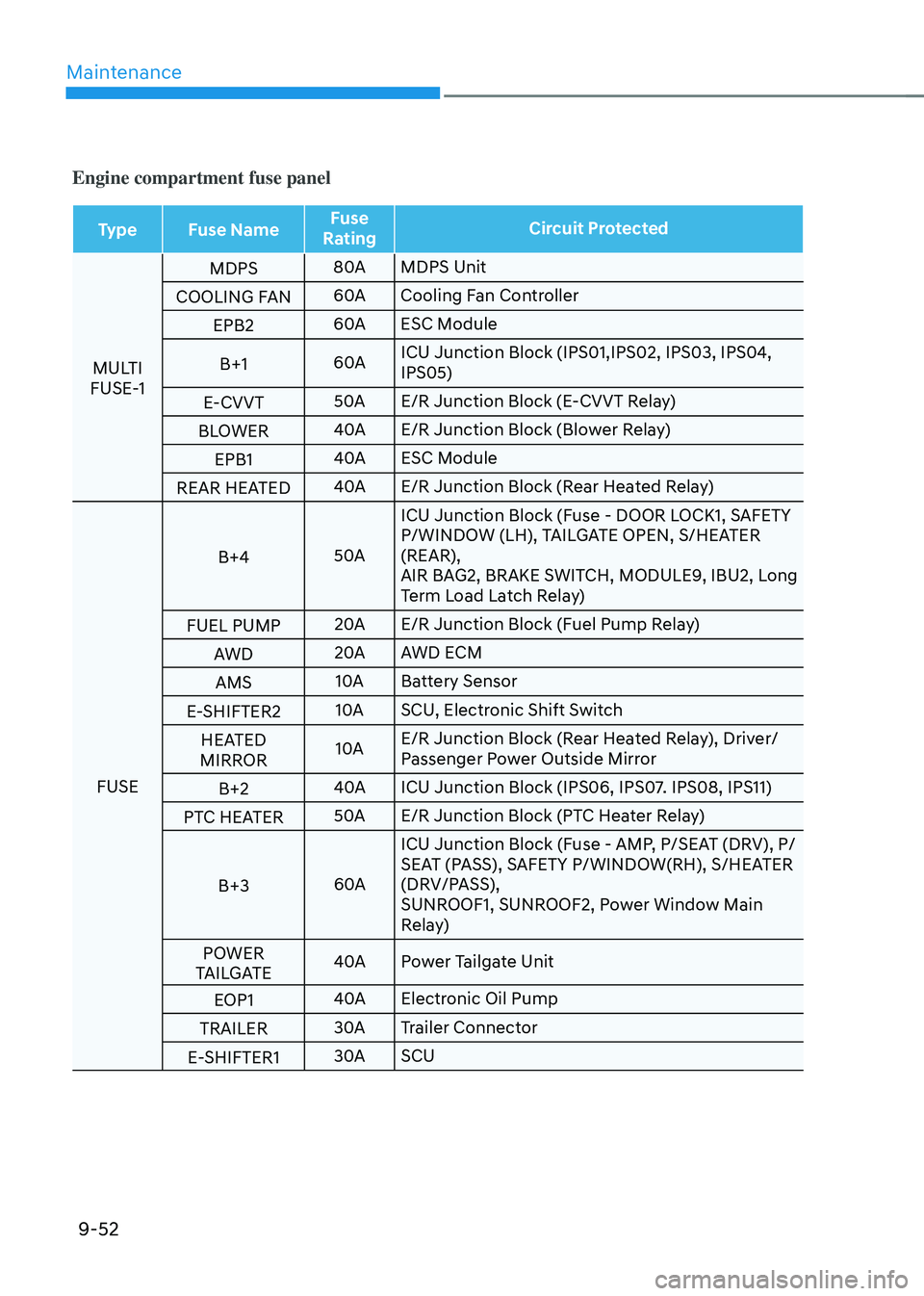
Maintenance
9-52
Engine compartment fuse panel
TypeFuse Name Fuse
Rating Circuit Protected
MULTI
FUSE-1 MDPS
80A
MDPS Unit
COOLING FAN 60A
Cooling Fan Controller
EPB2 60A
ESC Module
B+1 60AICU Junction Block (IPS01,IPS02, IPS03, IPS04,
IPS05)
E-CVVT 50A
E/R Junction Block (E-CVVT Relay)
BLOWER 40A
E/R Junction Block (Blower Relay)
EPB1 40A
ESC Module
REAR HEATED 40A
E/R Junction Block (Rear Heated Relay)
FUSE B+4
50AICU Junction Block (Fuse - DOOR LOCK1, SAFETY
P/WINDOW (LH), TAILGATE OPEN, S/HEATER
(REAR),
AIR BAG2, BRAKE SWITCH, MODULE9, IBU2, Long
Term Load Latch Relay)
FUEL PUMP 20A
E/R Junction Block (Fuel Pump Relay)
AWD 20A
AWD ECM
AMS 10A
Battery Sensor
E-SHIFTER2 10A
SCU, Electronic Shift Switch
HEATED
MIRROR 10A
E/R Junction Block (Rear Heated Relay), Driver/
Passenger Power Outside Mirror
B+2 40A
ICU Junction Block (IPS06, IPS07. IPS08, IPS11)
PTC HEATER 50A
E/R Junction Block (PTC Heater Relay)
B+3 60AICU Junction Block (Fuse - AMP, P/SEAT (DRV), P/
SEAT (PASS), SAFETY P/WINDOW(RH), S/HEATER
(DRV/PASS),
SUNROOF1, SUNROOF2, Power Window Main
Relay)
POWER
TAILGATE 40A
Power Tailgate Unit
EOP1 40A
Electronic Oil Pump
TRAILER 30A
Trailer Connector
E-SHIFTER1 30A
SCU